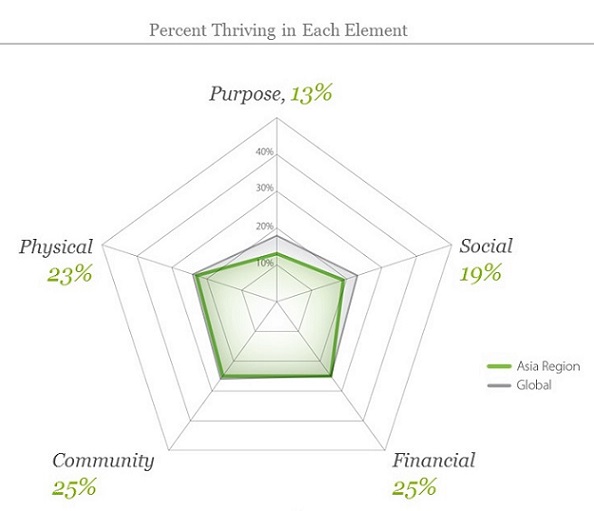Well-Being in Asia Pacific, the World’s Most Populous Region
Asia Pacific is a region characterized by a wide range of wealth and development, with countries such as Australia, New Zealand and Japan on one end of the spectrum and countries such as Afghanistan, Bangladesh and Pakistan on the other. As uncovered by the recently released Gallup-Sharecare Global Well-Being Index™, the distribution of well-being is likewise quite broad. New Zealand, Australia, Malaysia and the Philippines all have more than 24 percent of their residents thriving in three or more elements of well-being, while Bhutan has only 8 percent and Afghanistan has only 1 percent.
The Global Well-Being Index is a definitive measure and empiric database of real-time changes in well-being. The most comprehensive measure of well-being in the world, the Index uses a holistic definition of well-being and self-reported data from individuals to capture the important aspects of how people feel about and experience their daily lives, extending well beyond conventional measures of physical health or economic indicators. The five elements of well-being are purpose, social, financial, community and physical.
The Global Well-Being Index reveals that in three of the five well-being elements, the region is fairly close to the world averages in terms of the percentage of residents thriving in that element:
- Financial (25 percent in both Asia Pacific and worldwide)
- Community (25 percent in Asia Pacific versus 26 percent worldwide)
- Physical (23 percent in Asia Pacific versus 24 percent worldwide)
In the other two well-being elements, Asia Pacific is lagging behind global averages. In purpose well-being, only 13 percent of residents are thriving, compared with 18 percent worldwide. The Philippines, New Zealand, Australia and Thailand top the region in this element, whereas only 1 percent of Afghans are thriving in purpose. The Philippines has the region’s highest purpose well-being percentage, at 32 percent. Filipinos have historically reported high positivity related to employment, which may explain their strong showing in this element.
The other element in which Asia Pacific trails the global number is social well-being. In Asia Pacific, 19 percent are thriving, as opposed to 23 percent globally. Forty-three percent of Mongolians and 42 percent of Vietnamese report thriving in social well-being (more than double the regional percentage). Once again, on the opposite end of the range is Afghanistan, with less than half of 1 percent of residents thriving.
In a recent webinar, panelists from Gallup and Sharecare provided attendees with an exclusive and in-depth analysis of the findings for Asia Pacific. They provided an overview of well-being within the region, including a more extensive look at select countries, such as China, India and Indonesia. The panelists explained the importance of measuring well-being and offered proposed solutions as to what countries within the region can do to improve well-being.
To learn more about well-being in Asia Pacific, you can replay our webinar “Measuring Matters: Insights on Asia Pacific from the Gallup-Healthways Well-Being Index”. You can also download our State of Global Well-Being Report, which has details on Asia Pacific and much more.
